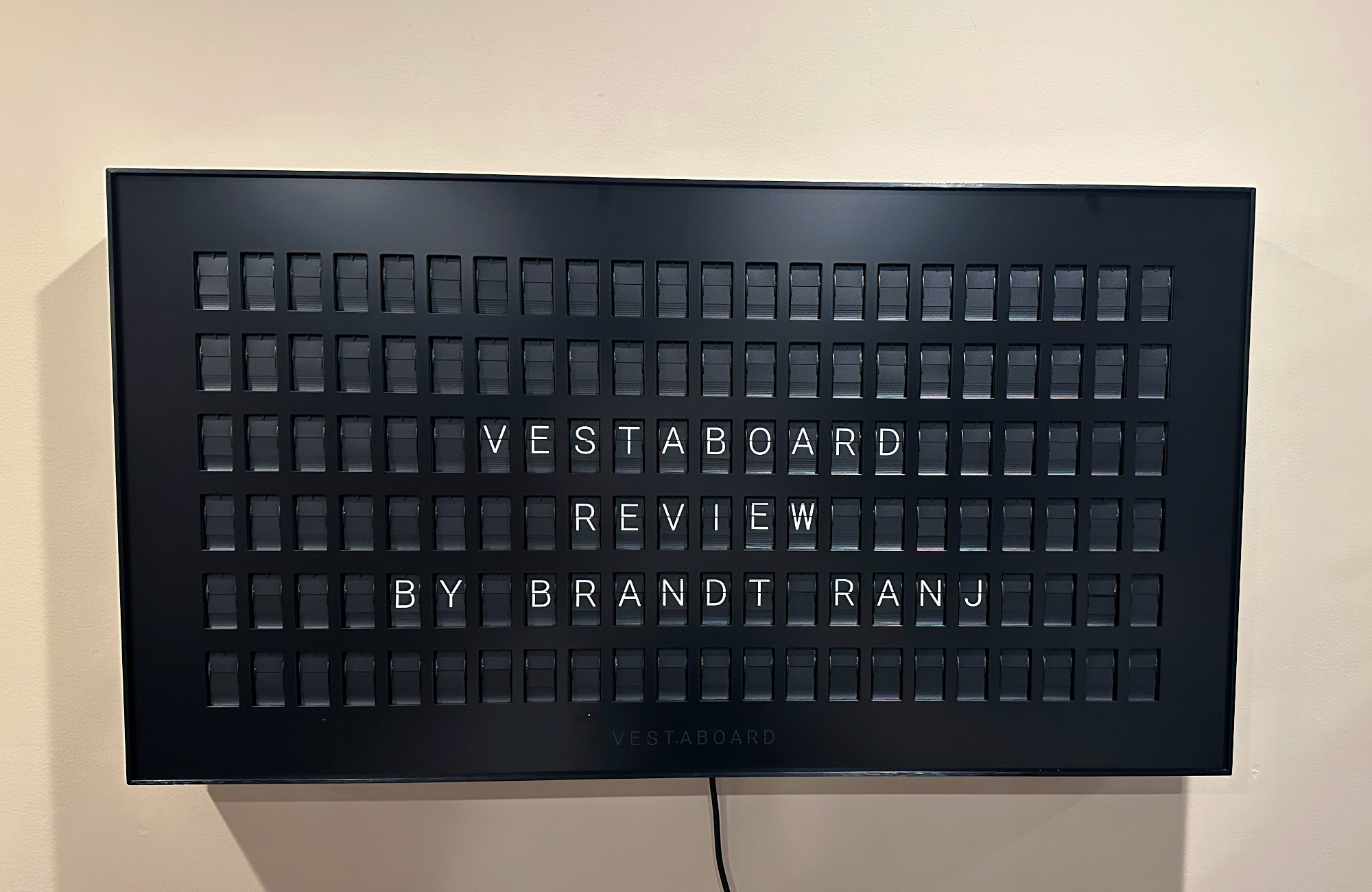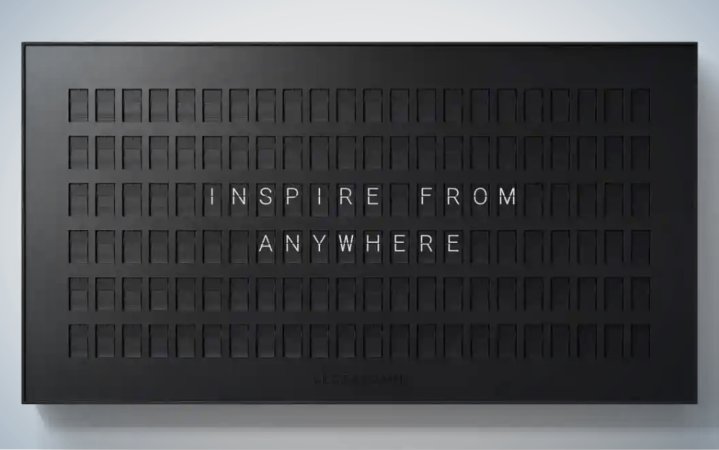

We may earn revenue from the products available on this page and participate in affiliate programs. Learn more ›
When I look toward the future of technology, my first inclination isn’t to take inspiration from a mid-20th century train scheduling board, but that’s exactly what drove Vestaboard CEO Dorrian Porter to create one of the most interesting gadgets I’ve seen in several years.
Vestaboard
What is the Vestaboard?
The Vestaboard is a 55-pound, three-and-a-half-foot-long internet-connected display. However, instead of an LED, LCD, or E-Ink screen, it’s composed of 132 individual “Bits,” modular character units in a 22×6 layout that flip to reveal messaging when you interact with it. Watching each Bit cycle through numbers, letters, symbols, and colors (64 possibilities per Bit) is always mesmerizing. Yes, the Bits audibly flap when they flip (and they’re rated for millions of cycles), but that only adds to the pleasing ambiance. Its design may be a throwback to classic transit boards, etc., but, in many ways, the Vestaboard is at the cutting edge of a concept called “ambient computing,” where digital information becomes available without you necessarily having to do anything.
The Vestaboard is effectively a digital message board where you (and up to six people you grant access to) can post text. The company’s app includes an assortment of quotes and color patterns as possible examples, then leaves you to your creative devices. I found myself sending random messages to the Vestaboard for amusement—this never got old—and my partner could send notes at her leisure. Yes, you can share access to your Vestaboard with a small group of people, and they can write whatever they want whenever they want from wherever they are. You can disable this feature or put the Vestaboard into a do-not-disturb mode to avoid drunk texts waking you up in the middle of the night.
The Vestaboard’s core functionality is rock solid—but does this level of fun justify its $3,295 price tag (shipping included) when sending texts, which can include GIFs, links to websites, and other rich information completely free? Not necessarily. However, there’s definitely something about the eye-catching display, once mounted and connected, that’s immediately and repeatedly satisfying, so let’s explore its allure.
Setting up the Vestaboard
Assembling the Vestaboard was very straightforward—written instructions were included, and the company’s YouTube channel offers a well-made step-by-step setup video. First, you need to attach the Vestaboard’s mount to your wall, and the company provides a guide so you know where to make your screw holes once you’ve found your studs. Once the mount is attached, you and another person need to lift the board and hook it into the mount. Finally, the Vestaboard’s outer frame gets placed on top of the board. The board won’t work unless the frame is attached to the top of it.
Getting the Vestaboard onto your wall requires two people because of its size. At 41.2 inches wide, 22 inches tall, and 3.2 inches deep, the board is too heavy and unwieldy to be installed alone. If you don’t feel like putting holes in your wall or want to set the Vestaboard up in a public place or rental, you can remove the mounting rails from the back of the board and lean it against a sturdy stand. I set the Vestaboard up this way and it performed identically to when it was on my wall. The power cable Vestaboard provides with the board is pretty short, but I could use it with an extension cord without any issues.
Once it was in the right place, I plugged the Vestaboard into power and walked through the software setup process. The board will begin by flipping all of its bits to ensure they’re working properly before displaying a unique code, which needs to be inputted into the Vestaboard mobile app (Android and iOS—I used an iPhone 14). The only other step was connecting the board to your network. The Vestaboard can be connected to the internet over Wi-Fi or hardwired using an Ethernet cable. I’ve been using the Vestaboard over Wi-Fi and didn’t notice any lag during my tests.

Using the Vestaboard
I’m so used to relying on screens—a smartwatch on my wrist offering biometric data, a computer used mostly for work, a 4K TV for entertainment, a smartphone for communication—that the Vestaboard felt like a breath of fresh air. A gadget combining the utility of digital communication in an analog format. I liked seeing information displayed on the Vestaboard more than when it popped up on my phone’s screen. Phone and computer notifications can elicit a certain level of stress—who’s messaging me and why—in a way the Vestaboard never did. In fact, it was quite the opposite; every time I used the Vestaboard, it felt like a treat, though the log of messages and other information was far more limited. I’ve come to think of it as the difference between receiving an email vs. a physical letter.
Messaging doesn’t quite warrant the Vestaboard’s high price, and the company has locked its display’s coolest features behind a paid service, Vestaboard+, which greatly expands its capabilities. Vestaboard+ costs $95 per year and gives you unlimited access to dozens of apps that access its API. You can link the Vestaboard to news services like CNN or The New York Times to update with new headlines at a set interval, ask to cycle through ’90s lyrics, or set up and play a word game. The coolest Vestaboard+ apps, in my experience, were the ones that automatically updated the display to show the current song I was streaming—helpful when listening to a playlist recommended to me by an algorithm—and another that’d cycle through the flags of different countries. Vestaboard gives you control over how often the screen updates for some Vestaboard+ apps, so they never got too distracting.
Vestaboard+ apps are the main reason to pick one up for personal use. Having weather, updated sports scores, and similar information coming automatically through the airwaves onto a dynamic analog display at preset times feels retrofuturistic in the best ways. Yes, you can program this information to pop up on your phone or replicate some of the Vestaboard’s functionality on a $249 Echo Show 10. Still, there’s something cool about seeing updated info flip around on the big board. For individual use, it’s hard to see this as anything more than an incredibly cool indulgence. You’ll need the space, money, aesthetics, and interest in technology to rationalize the purchase. If you check all those boxes, though, you’ll find a lot to like about it.

So, who should buy the Vestaboard?
If you’re a business owner, run—don’t walk—to pick one up (though run carefully with a sturdy dolly to wheel it back). The Vestaboard’s utility as a display for today’s specials, a menu with updated pricing, or a scoreboard for trivia nights is unparalleled. It’s the type of gadget that’ll get people talking, much more so than putting the same information up on a 4K TV. Throughout my time with the Vestaboard, I continually thought of ways to use it in a cafe, bar, restaurant, or venue.
Every scenario—from cycling through details about a couple at their wedding reception to having a late-night bar whose weekend specials change every hour on the hour—filtered through my mind. The Vestaboard’s utility in disseminating information within communal spaces, especially where personal electronics aren’t allowed or the internet isn’t public, is completely logical. Yes, the Vestaboard is still a pretty big expense for most businesses, but it’s an easier cost to swallow in this capacity.
We’ve mentioned this several times, but a big part of the Vestaboard’s appeal for either individual or professional use is how it looks and works. It’s genuinely fun to see the Bits flip while a custom message slowly comes into view. This is especially true if there’s suspense behind what you’re writing—like a baby gender reveal. Personally, I’m waiting for a Mega Millions Vestaboard+ app where the winning numbers are displayed as they’re coming in or the ability to use the Vestaboard to communicate with an AI like ChatGPT or the like.
The Vestaboard’s hardware is already world-class, but it’s up to the company to continue to innovate on the software side. Lowering the price would be another obvious route to expand the Vestaboard’s appeal. Still, given its size and the custom-designed physical mechanisms involved in creating it, that doesn’t seem likely. If Vestaboard somehow managed to create a smaller, desktop-friendly version, I’d be the first in line to check one out.

At the end of the day, the Vestaboard is an interesting—albeit expensive—gadget whose features can be imitated, but not fully replicated, by fully digital devices that cost less than one-tenth its price. It’d be easy to write the device off as a gimmick, but its fit, finish, and polished software experience would suggest otherwise. If the company can continue to find new and interesting ways to expand its platform, it could have a surprise hit on its hands. As it stands, the Vestaboard is primarily a tech hobbyist’s dream device and a genuinely useful business tool.

